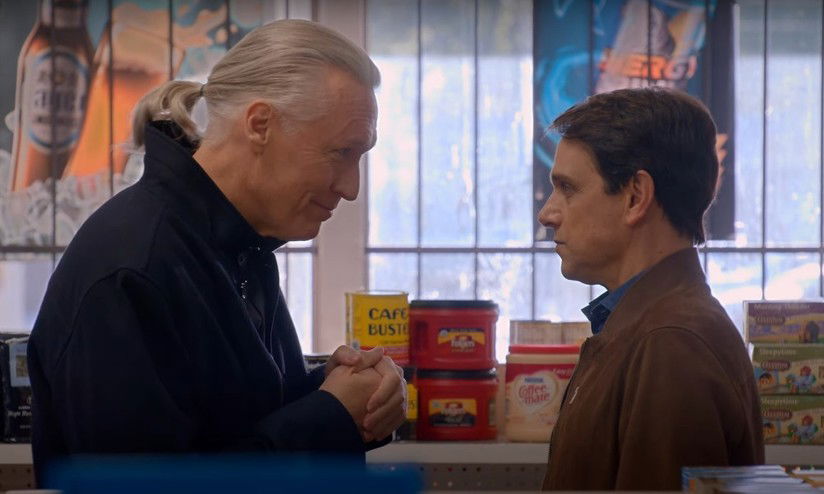Recensione di Cobra Kai 4
25 Gennaio 2022
di Stefano Olivari

Abbiamo centellinato i dieci episodi della quarta stagione di Cobra Kai, dal 31 dicembre disponibile su Netflix, resistendo alla tentazione del binge watching, ma purtroppo abbiamo finito di vederli tutti e l’unica consolazione è che al 100% ci sarà un Cobra Kai 5, vista la quantità di storie lasciate aperte e di personaggi in evoluzione. Con interessanti variazioni sul tema ed i buoni che non vincono sempre, nella vita e nel karate, e forse non sempre meritano di vincere. No spoiler, non preoccupatevi. Diciamo soltanto che c’è un arbitro corrotto, ma poi i vincitori hanno legittimato.
Insomma, il geniale seguito televisivo dei tre Karate Kid (non contiamo quello pur buono con Hilary Swank e nemmeno il reboot del 2010) cinematografici ha ancora vita, ed è stato addirittura capace di conquistarsi una vita propria intercettando vari pubblici: nostalgici anni Ottanta, giovani di oggi (si parla di inadeguatezza, bullismo, solitudine: non che negli anni Ottanta questi problemi fossero assenti, ma se ne parlava meno), cultori dei teen movie e dei romanzi di formazione, gente di tutte le età in grado di cogliere le tante citazioni e soprattutto l’ironia del tutto.
Lo schema di partenza è quello maestro-allievo, sia fra i buoni sia fra i cattivi, ma da lì ogni incrocio è possibile e la marcia di avvicinamento all’All Valley, cioè la nuova edizione del torneo che nel 1984 con quel memorabile calcio diede la gloria eterna a Daniel LaRusso-Ralph Macchio è tutt’altro che banale. Detto che impazziamo per Johnny Lawrence-William Zabka e per il suo essere fuori dal tempo, il vero nuovo personaggio di Cobra Kai 4 è Terry Silver, ex commilitone di Kreese in Vietnam, adesso ricco imprenditore ma con il fuoco del karate e della lotta che aspetta soltanto di riaccendersi: scena di culto quando in cantina spacca una bottiglia di vino costosissima.
Anche in questo caso la genialata è stata quella di inserire personaggi dei vecchi Karate Kid facendoli interpretare dagli attori originali: Silver-Thomas Ian Griffith esce da Karate Kid III, quello della rottura, poi ricomposta, di Daniel con il maestro Miyagi. Grande spazio al figlio maschio dei LaRusso, Anthony, che conta meno della sorella Samantha ma rispetto alle stagioni precedenti è molto più utilizzato: il suo rapporto con il quasi coetaneo Kenny Payne, con la distinzione fra bullo e bullizzato che cambia di continuo, promette bene.
Quasi tutti i personaggi hanno un’evoluzione e vengono costretti dalle circostanze a cambiare il loro punto di vista in una maniera interessante, cioè formandosene uno proprio, secondo il più dimenticato degli insegnamenti di Miyagi. Una serie che migliora stagione dopo stagione, gli anni Ottanta che non generano nostalgia sterile, buona per l’aperitivo con pasta fredda e nachos rancidi, ma lo spirito positivo per affrontare vita e futuro. Certo la regia cazzuta dell’immenso e defunto John Avildsen un po’ ci manca, ma i tempi sono diversi ed in fondo anche questi sono i nostri tempi.
We have centered the ten episodes of the fourth season of Cobra Kai, from December 31 available on Netflix, resisting the temptation of binge watching, but unfortunately we finished watching them all and the only consolation is that 100% there will be a Cobra Kai 5, given the amount of stories left open and evolving characters. With interesting variations on the theme and the good guys who don’t always win, in life and in karate, and maybe don’t always deserve to win. No spoilers, don’t worry. Let’s just say that there is a corrupt referee, but then the winners legitimized.
In short, the brilliant television sequel of the three Karate Kid (we do not count the good one with Hilary Swank and even the 2010 reboot) film still has life, and has even been able to conquer a life of its own by intercepting various audiences: nostalgic eighties, young people of today (it talks about inadequacy, bullying, loneliness: not that in the eighties these problems were absent, but it was less talked about), lovers of teen movies and novels of formation, people of all ages able to grasp the many quotes and especially the irony of the whole.
The starting pattern is that of master-pupil, both among the good guys and the bad guys, but from there every intersection is possible and the march towards the All Valley, that is the new edition of the tournament that in 1984 with that memorable kick gave eternal glory to Daniel LaRusso-Ralph Macchio is anything but trivial. Having said that we are crazy for Johnny Lawrence-William Zabka and for his being out of time, the real new character of Cobra Kai 4 is Terry Silver, Kreese’s former comrade in Vietnam, now a rich entrepreneur but with the fire of karate and fighting just waiting to be rekindled: cult scene when in the cellar he smashes a bottle of expensive wine.
Also in this case the genius was to include characters from the old Karate Kid by having them played by the original actors: Silver-Thomas Ian Griffith comes out of Karate Kid III, the one of the breakup, then recomposed, of Daniel with the master Miyagi. Great space for the LaRusso’s son, Anthony, who counts less than his sister Samantha but compared to previous seasons is much more used: his relationship with the almost peer Kenny Payne, with the distinction between bully and bullied that changes constantly, promises well.
Almost all the characters have an evolution and are forced by circumstances to change their point of view in an interesting way, that is, forming their own, according to the most forgotten of Miyagi’s teachings. A series that improves season after season, the eighties that do not generate sterile nostalgia, good for the aperitif with cold pasta and rancid nachos, but the positive spirit to face life and the future. Of course the badass direction of the immense and deceased John Avildsen we miss a bit, but times are different and after all these are our times.
Translated with www.DeepL.com/Translator (free version)





Commenti Recenti